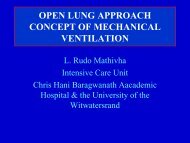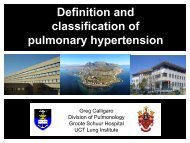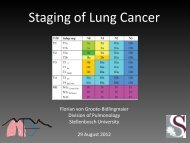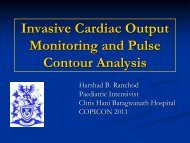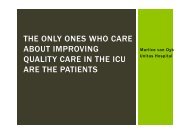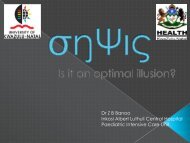Brendan McCormack Teamwork Issues effectiveness and importance
Brendan McCormack Teamwork Issues effectiveness and importance
Brendan McCormack Teamwork Issues effectiveness and importance
Create successful ePaper yourself
Turn your PDF publications into a flip-book with our unique Google optimized e-Paper software.
<strong>Teamwork</strong>:<br />
issues,<br />
<strong>effectiveness</strong><br />
<strong>and</strong> <strong>importance</strong><br />
Professor <strong>Brendan</strong> <strong>McCormack</strong><br />
Director, Institute of Nursing & Health Research <strong>and</strong> Head of<br />
the Person-centred Practice Research Centre, University of<br />
Ulster.<br />
Professor II, Buskerud University College, Drammen, Norway;<br />
Adjunct Professor of Nursing, University of Technology, Sydney;<br />
Adjunct Professor of Nursing, Monash University, Melbourne;<br />
Visiting Professor, School of Medicine & Dentistry, University of Aberdeen.
Presentation Focus<br />
• Clinical <strong>and</strong> Therapeutic <strong>effectiveness</strong><br />
• Key issues in team functioning<br />
• Human Flourishing<br />
• Workplace Culture
Clinical Effectiveness<br />
“the extent to which clinical interventions<br />
when deployed in the field for a<br />
particular patient or population do what<br />
they are intended to do, that is, maintain<br />
<strong>and</strong> improve health <strong>and</strong> secure the<br />
greatest possible health gain from<br />
available resources”<br />
[DoH, 1996]
‘doing the thing right’ whilst<br />
doing the thing right whilst<br />
‘doing the right thing’
Therapeutic Effectiveness<br />
Therapeutic reciprocity it is a fundamental<br />
support system to sustain <strong>and</strong> develop<br />
peoples’ therapeutic <strong>effectiveness</strong>. It relies<br />
on a team culture that encourages<br />
practitioners to be sensitive to their<br />
practice, open to meaningful challenge<br />
about practice, where there is access to<br />
support <strong>and</strong> development <strong>and</strong> a<br />
commitment to reflection on practice.
Practice Context<br />
• Highly political & unsettling<br />
Requires:<br />
spaces that provide opportunities for creative problem<br />
solving <strong>and</strong> the determining of practical, context specific<br />
solutions <strong>and</strong> that create sufficient psychological safety<br />
(Brown & <strong>McCormack</strong> 2010)
Psychologically Unsafe Environments:<br />
characterised by …<br />
• Misuse of power <strong>and</strong> lack of autonomy<br />
• Horizontal violence <strong>and</strong> oppressed<br />
behaviours<br />
• Transactional leadership<br />
(Brown & <strong>McCormack</strong> 2010)
Twenty years as a nurse<br />
Moving through the ranks knowing<br />
who I am<br />
Knowing me<br />
Becoming a manager, being a manager<br />
Managing<br />
Discovering the joys of personcentredness<br />
Unfurling the challenges of being a<br />
person-centred leader<br />
Self growth<br />
Discovery<br />
Transformation<br />
The winds of change blow from the west<br />
Person-centred leadership devalued<br />
Targets<br />
Bullying<br />
Devaluing<br />
I am an ‘It’<br />
Stats mean good care<br />
Shared experiences mean coercion<br />
Get out get out get out<br />
Stay safe<br />
Shut down<br />
Hide<br />
But I need to keep listening to the<br />
But I need to keep listening to the<br />
patients
What is a team<br />
• “a group in which the individuals have a<br />
common aim <strong>and</strong> in which the jobs <strong>and</strong> skills of<br />
each member fit in with those of others, as ... in<br />
a jigsaw puzzle pieces fit together without<br />
distortion <strong>and</strong> together produce some overall<br />
pattern”.<br />
• “an effective team may be defined as one that<br />
achieves its aim in the most efficient way <strong>and</strong> is<br />
then ready to take on more challenging tasks if<br />
so required”. [Adair, 1986]
What is a team<br />
•The task<br />
•The individual<br />
•The group
The Task<br />
• common sense of purpose<br />
• clearly defined task(s)<br />
• clarity about roles to match the task(s)<br />
• balance of tasks with services<br />
• knowledge, skills <strong>and</strong> expertise required<br />
for effective task completion
The Individual<br />
id
Human<br />
Flourishing<br />
Human flourishing<br />
occurs when a<br />
person is<br />
concurrently doing<br />
what he [sic] ought<br />
to do <strong>and</strong> doing<br />
what he wants to do<br />
(Aristotle)
The Four<br />
Elements of<br />
Flourishing<br />
• Challenge<br />
• Connectivity<br />
• Autonomy<br />
• Using your<br />
valued<br />
competencies<br />
(Gaffney, 2011)
Emotional Survival<br />
• Depends on …<br />
– Feeling psychologically og ca y safe<br />
– Feeling good about oneself<br />
– Feeling close <strong>and</strong> respected in relationships<br />
<strong>and</strong> groups that are important<br />
(Gaffney 2011)
• Motivated t to act<br />
Helping individuals to<br />
Flourish in the Workplace<br />
• Respect from others <strong>and</strong> self-respect<br />
• Fulfilment of potential for growth<br />
• Satisfaction <strong>and</strong> security<br />
• Reward for effort
The Group<br />
• team philosophy<br />
• a shared agenda<br />
• shared decision-making processes<br />
• effective use of resources<br />
• effective co-ordination<br />
• communication, i feedback & evaluation<br />
• collaborative, inclusive & participative<br />
p
The need for leadership that is shared,<br />
distributed <strong>and</strong> adaptive<br />
• Person-centred Situational Leadership<br />
(Lynch et al 2011)<br />
• Clarity of leadership vs management<br />
functions <strong>and</strong> roles (Dewing &<br />
<strong>McCormack</strong>, in progress)<br />
• Shared governance models
mmmmmmmmmmmmmmmmmmmm<br />
mmmmmmmmmmmmmmmmmmmm Developing effective<br />
mmmmmmmmmmmmmmmmmmmm workplace cultures for<br />
mmmmmmmmmmmmmmmmmmmm team/therapeutic<br />
mmmmmmmmmmmmmmmmmmmm<br />
mmmmmmmmmmmmmmmmmmmm<br />
<strong>effectiveness</strong> requires<br />
mmmmmmmmmmmmmmmmmmmm the changing gof<br />
mmmm<br />
patterns
Patterns are often ignored or go unchallenged despite<br />
changes to structures <strong>and</strong> processes (Plsek 2001; Ill 2005).<br />
This is because patterns are associated with distinctive<br />
behavioural norms that manifest specific values, beliefs <strong>and</strong><br />
assumptions within a workplace. These aspects together by<br />
definition are termed ‘culture’ (Schein, 2004) where implicit<br />
<strong>importance</strong> is placed on how things are done <strong>and</strong> what<br />
counts as important. To bring about fundamental change in<br />
complex systems requires the recognition of patterns that<br />
drive thinking <strong>and</strong> behaviour (Plsek 2001).
Patterns describe problems that occur over<br />
<strong>and</strong> over again in a team <strong>and</strong> they describe<br />
the core of a solution to that problem in<br />
such a way that it can be used a million<br />
times over – without t ever doing it the same<br />
way twice. As such, patterns can be very<br />
generalised at a conceptual level l while they<br />
are absolutely unique at a local<br />
implementation ti level. l
EFFECTIVE WORKPLACE CULTURE<br />
concept analysis<br />
(Manley et al 2012)<br />
Enabling Factors Essential Attributes Consequences<br />
INDIVIDUAL:<br />
•Transformational<br />
leadership<br />
•Skilled facilitation<br />
•Role clarification<br />
ORGANISATIONAL:<br />
•Flattened &<br />
transparent<br />
management<br />
•Organisational<br />
readiness<br />
•Human resource<br />
management support<br />
1. Specific values promoted in the workplace,<br />
namely:<br />
m1<br />
• Person-centredness<br />
• Lifelong learning<br />
• Support <strong>and</strong> challenge<br />
• Leadership development<br />
• Involvement & participation i by stakeholders<br />
• Evidence-use <strong>and</strong> development<br />
• Positive attitude to change<br />
• Open communication<br />
• <strong>Teamwork</strong><br />
2. All the above values are realised in practice,<br />
there is a shared vision & mission <strong>and</strong>, individual<br />
& collective responsibility<br />
3. Adaptability, innovation & creativity maintain<br />
workplace <strong>effectiveness</strong><br />
4. Appropriate change is driven by the needs of<br />
patients/users/communities<br />
5. Formal systems exist to continuously enable <strong>and</strong><br />
evaluate learning, performance <strong>and</strong> shared<br />
governance 3 :<br />
•Continuous evidence<br />
that:<br />
‣Patients, users,<br />
communities needs are<br />
met in a person-centred<br />
way<br />
‣Staff are empowered &<br />
committed<br />
‣St<strong>and</strong>ards & goals are<br />
met (individual, team,<br />
organisational<br />
<strong>effectiveness</strong>, includes<br />
safety)<br />
‣Knowledge/evidence is<br />
developed, used &<br />
shared<br />
‣Human flourishing<br />
•Influence on other<br />
idiocultures
Slide 23<br />
m1 manleyk, 2005/04/06
Developing Effective Workplace<br />
Cultures through Emancipatory<br />
Practice Development<br />
A Case Study of the Belfast Health<br />
<strong>and</strong> Social Care Trust<br />
Professor Tanya McCance, Ms Bernadette<br />
Gribben, Ms Elizabeth Mitchell, <strong>and</strong> Professor<br />
<strong>Brendan</strong> <strong>McCormack</strong><br />
(McCance et al, in press; <strong>McCormack</strong> & McCance, in press)
Project Aims<br />
• demonstrate a greater knowledge <strong>and</strong><br />
underst<strong>and</strong>ing of the principles of person<br />
centredness<br />
• demonstrate an underst<strong>and</strong>ing of the<br />
emerging challenges to providing person<br />
centred care<br />
• identify outcomes for staff <strong>and</strong> patients as a<br />
result of practice change
Participating Acute Hospital sites<br />
• Cancer Inpatient Unit<br />
• Mental Health Inpatient Unit<br />
• Brain Injury Unit<br />
• Specialist <strong>and</strong> General Medical Inpatient Wards<br />
- Chest Medicine<br />
- Cardiology Intervention<br />
- Medicine/ Respiratory<br />
- Medical/ Hepatology<br />
- Neurology<br />
• Eyes <strong>and</strong> ENT Theatre Department
Programme Facilitation & Management<br />
• The programme was implemented over a period of 18<br />
months.<br />
• High level Steering Group<br />
• Implementation Team comprising of Ward Managers,<br />
Nursing Development Leaders <strong>and</strong> Service Managers<br />
from each of the participating sites.<br />
• Internal/external facilitation<br />
• Service user involvement e was obtained through<br />
involvement in programme activities e.g. patient stories<br />
<strong>and</strong> observations of practice.
Development Themes<br />
• Theme 1:<br />
• Theme 2:<br />
• Theme 3:<br />
• Theme 4:<br />
Promoting an awareness <strong>and</strong><br />
underst<strong>and</strong>ing of person-<br />
centredness<br />
Developing a shared vision<br />
Determining the existing quality<br />
of the user experience<br />
Developing practice
Data Collected<br />
• Patient stories<br />
• Implementation team 1: interviews<br />
• Implementation team focus groups<br />
• Key stakeholder focus group<br />
• Reflective accounts (participants)<br />
• Stakeholder Evaluation (Claims, Concerns<br />
<strong>and</strong> <strong>Issues</strong> [Guba & Lincoln 1989])<br />
• Practice changes specific evaluations (e.g.<br />
improvements in patient flow)
Summary of Key Findings<br />
Enabling Conflicting Living Person-<br />
Engagement Pi Prioritiesiti<br />
Centred Care<br />
• Ways of working<br />
• Building<br />
relationships<br />
• Maintaining<br />
momentum<br />
• Feeling<br />
pressurised<br />
• Staffing<br />
resources<br />
• Evolving context<br />
• Embracing<br />
person-centred<br />
values<br />
• Being confident<br />
<strong>and</strong> competent
“meaningful critically reflective<br />
conversations that lead to<br />
support for, <strong>and</strong> engagement<br />
with, the changes that teams<br />
initiate as a result of the<br />
learning"
Coming together is a beginning.<br />
Keeping together th is progress.<br />
Working together is success.<br />
(Henry Ford)



